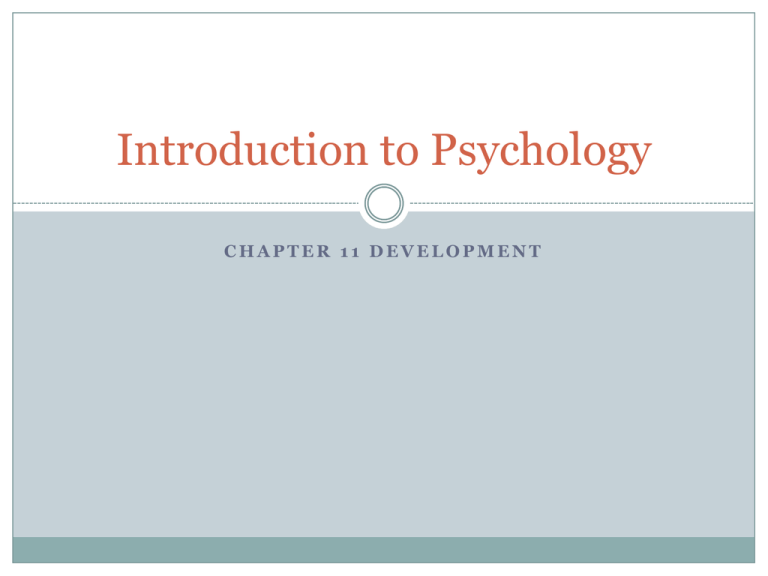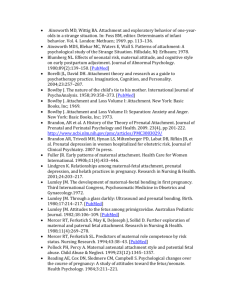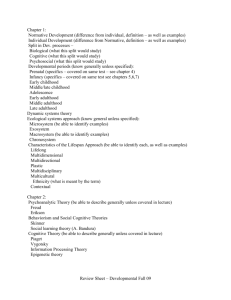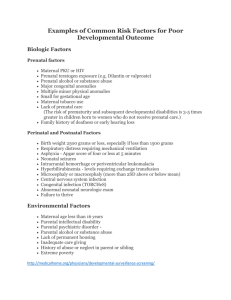Chapter 11 - Development
advertisement

Introduction to Psychology CHAPTER 11 DEVELOPMENT Development Development: change over time Developmental Psychology: the branch of psychology concerned with the interaction between physical and psychological processes over the lifespan “cradle to grave” Developmental Research Methods Normative investigation: research designed to describe the normal developmental trajectories of individuals Developmental age: the chronological age at which most children show a particular level of physical or mental development Developmental Research Methods Longitudinal design: the same participants are observed repeatedly, sometimes over many years Benefits of longitudinal designs Can infer causal relationships and developmental trajectories Problems with longitudinal designs Events can occur in between time-points that can influence results Participants drop out (attrition) or die (mortality) Usually expensive and time consuming Developmental Research Methods Cross-sectional design: groups of participants of different chronological ages are observed and compared at one time Benefits of cross-sectional designs Cost and time effective Can collect data in a relatively short period of time Problems with cross-sectional designs Social and political conditions can vary by cohort “Cohort Effects” Prenatal Development Zygote: the single cell that results when a sperm fertilizes an egg Contains 46 chromosomes Chromosome: rod-shaped structures that contain all basic hereditary information Gene: the individual part of the chromosome through which information is transmitted Individual genetic expression is determined by Epigenetic tags (Methyl groups and Histones) Interactions between the embryo and the uterine/ovo environment Prenatal Development Embryo: a developed zygote that has a heart, brain, and other organs Fetus: a developing individual from 8 weeks after conception [for humans] Vestibular system begins functioning Movement Major organs begin to function Age of viability: the point at which a fetus can survive if born prematurely The age of viability is becoming earlier and earlier due to advancements in medical technology Prenatal Development Prenatal Development Which one is a human? Vertebrate Embryos Prenatal Development Teratogens: environmental agents or factors that can produce a birth defect Maternal nutrition Maternal illness Maternal stress Maternal drug use Maternal alcohol use Fetal Alcohol Syndrome (FAS) Maternal nicotine use Prenatal Sensory Development The order in which sensory systems develop is the same across vertebrates: 1) vestibular (touch & motion) 2) chemoreception (taste & smell) 3) auditory 4) visual Learning does occur in-utero/ovo Human fetuses at 32 weeks can demonstrate a preference for a familiar nursery rhyme. Newborns can identify and prefer their mother’s voice and native language Postnatal Development Precocial: the organism is born with all of it’s sensory systems functioning and can “fend for its-self”. Example: baby antelope, chicken chick Altricial: the organism is born with immature sensory systems and cannot survive on it’s own Example: puppy, kitten Humans are born with a unique mix of precocial and altricial characteristics This mix may make it easier for us to acquire language and other social behaviors Postnatal Development Motor Development: The progression of muscular coordination required for physical activities Cephalocaudal trend (A) Head-to-foot direction of motor development Proximodistal trend (B) Center-to-outward direction of motor development Postnatal Development Eleanor Gibson Infants are equipped to investigate the world and to detect relationships between themselves and the environment Can detect invariances, such as gravity Can detect functional relationships, such as contingencies Affordances: opportunities to interact with and explore the environment The Visual Cliff Experiment http://www.youtube.com/watch?v=3WvtEFJGp-8&list=PLtoX6L88vjkf2YQn5R7NIOvnIxq78viPY Infancy & Attachment Attachment: emotional relationship between a child and their primary caregiver This first attachment has implications for all future relationships Depends on the interaction between the infant and their caregiver John Bowlby Attachment theorist that believed that infants and adults are genetically predisposed to form attachments; since attachment provides evolutionary benefits Mary Ainsworth Attachment style in childhood has implications for future relationships Skinner Attachment is the result of mutual conditioning between infant and caretaker Attachment Research Harlow’s Monkeys http://www.youtube.com/watch?v=OrNBEhzjg8I Ainsworth’s “Strange Situation” task Identified 3 attachment styles Securely attached Insecurely attached –Avoidant Insecurely attached – Anxious http://www.youtube.com/watch?v=PnFKaaOSPmk Eastern European Orphanages Temperament Temperament: characteristic mood, activity level, and emotional reactivity Easy children (40%) Slow-to-warm children (15%) Difficult children (10%) Mixed (35%) Parenting Styles Style Parent Behavior Child Behavior Authoritarian Rigid, punitive, strict Unsociable, withdrawn Permissive Lax, inconsistent, undemanding, but warm Immature, moody, lowself-control, dependent Authoritative Firm, sets limits and goals, encourages independence Good social skills, likeable, independent Uninvolved Emotionally detached, only provides basic needs Indifferent Erikson’s Psychosocial Stages of Development All humans go through the exact developmental stages in the same order The ages at which each stage occurs may be different depending on culture What is considered successful resolution of the crisis may be different between cultures Focus on the development of positive identity Erikson: Identity Formation Identity formation occurs during adolescence and emerging adulthood Identity diffusion: has not gone through an identity crisis and has not made any commitments Foreclosure: has not gone through an identity crisis, but has made commitments Moratorium: actively involved in exploring different identities and has yet to make a commitment Identity achievement: an individual who has explored different identities and has made a tentative commitment to one Piaget: Cognitive Development Piaget Cognitive Development Tests of cognitive development: Object Permanence Egocentrism Animism Conservation tasks Point-of-view tasks Possible Combinations (The Sandwich Task) Gender Identity Puberty: the period at which maturation of the sexual organs occurs Typically 11-12 for females (menarche) 13-14 males (spermarche) Gender identity development has been shown to begin in infancy Infants prefer the actions of a gender-matched model over those of the opposite gender at 10 months Sex: the biological presentation of males and females Gender: a psychological phenomenon that refers to learned sex- related behaviors and attitudes Different cultures have different accepted gender classifications http://www.youtube.com/watch?v=K9VmLJ3niVo Moral Development: Kohlberg’s Model Assessing Moral Development https://www.youtube.com/watch?v=CjPfI4Xu2CU Aging Disengagement theory of aging Aging produces gradual withdrawal from the world on physical, psychological, and social levels Activity theory of aging Suggests that elderly individuals that remain active in interests and activities from middle age are the most successful in the aging process Aging The importance of personal control in old age Langer & Rodin conducted a longitudinal study of elderly nursing home residents on the effect of personal choice on happiness and health Group 1: Standard nursing home care Group 2: Increased personal choice / responsibility Group 3: No personal choice / responsibility Residents given more autonomy were subjectively happier and had significantly better health measures compared to the other groups Residents in the No Control group had increased learned helplessness Aging and Death Life review: the process by which people examine and evaluate their lives Ego Integrity vs. Despair Coping with death Denial Anger Bargaining Depression Acceptance




